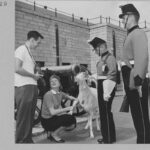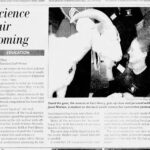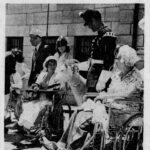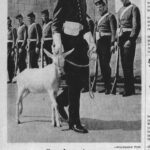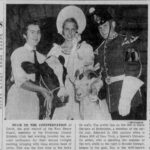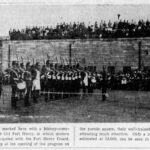Street Address: 366 King Street, Kingston Economic Development Corporation)
In 2016 the Canadian Dairy Commission signed a massive deal with a Chinese company Feihe to make Kingston home to North America’s first goat milk-based infant formula factory.[1] We are standing outside the Kingston Economic Development Corporation which was instrumental in securing this deal for the city.[2] Because of this deal there is expected to be a huge increase in goat populations in Ontario, possibly including as many as 2000 confined to an industrial farm at Joyceville Penitentiary.[3] The deal has received extensive criticism relating to workers rights,[4] animal rights, the environment, conflict of interest,[5] and the entanglement of goat milk supply with Canada’s Prison Farms.[6]
The most-commonly used goats in such milking operations are white Saanen goats, and this is not the first time Saanen goats have appeared in Kingston’s history. Between 1842 and 1843 the Royal Welch Fusiliers served at Fort Henry and brought with them their regimental goat, informally known as Billy and formally known as The Goat. The Royal Welch originally adopted regimental goats in 1775 when a goat strayed into the middle of the Battle of Bunker Hill during the American War of Independence.[7] Ever since, Billy has travelled with this regiment across the world including during World War 1 and 2 and to places like Hong Kong, India, and across Canada.
The role of animals as regimental mascots may seem something of a novelty, but the business of conscripting animals into the military is deadly serious. Millions of these conscripts (including horses, dogs, donkeys, pigeons, dolphins, and others) died in 20th century wars alone. They have been memorialized in war monuments around the world, including Ottawa, but not, so far, in Kingston.
In 1953, the St David’s Society of Toronto presented the Fort Henry Guard with a white Saanen goat to honour the tradition started by the Fusiliers.[8] Ever since, Fort Henry (which can be spotted across the Kingston harbour) has been home to a regimental goat named David, after the patron saint of Wales. David the 12th started his position in 2018 and is still at the fort. David’s military rank is Lance Corporeal and at any given point he outranks over two thirds of the Guard at the Fort.[9] Every day David leads the men on parade and is on view for visitors. Historically, David sometimes travelled and was often used to meet important guests at the Fort. For example, in 1955 he travelled with the Fort Henry guards to Washington,[10] and later in the month “much to his consternation”, he greeted the Frontenac County Holstein Club.[11]
Over the years, concerns for David’s welfare have gained greater attention. Saanen goats, like all goats, traditionally live in matrilineal herds with strong social hierarchies. To reduce David’s social isolation, it was decided in 2018 to introduce a friend and so Henrietta joined David.[12] Unlike David, who must participate in parades and holds rank, Henrietta is not an official regimental goat but rather David’s companion.
Another important person for David the 12th is his Goat Major who is tasked with taking care of him. Goat Major Brynne Ferguson has worked with three different goats: David the 11th, David the 12th and Henrietta. In an interview with Hilltop History, Ferguson said getting to know the goats has been the most rewarding part of her job and that all three of the goats she has worked with have had distinctive personalities.[13] Henrietta is extremely social, enjoys being rubbed, and loves eating apples and cucumbers. David the 12th on the other hand likes playing games, jumping off chairs, and eating carrots. While Henrietta has made several friendships with men in the Guard, David the 12th is particularly attached to Goat Major Ferguson as he has known her since he was 2 months old. Ferguson feels the same, saying: “It’s a relationship I know I will never be able to replicate any where else…there is just so much trust and so much love between me and this goat.”[14] It is interesting to think about how different the lives of the white Saanens at the prison factory farm will be from those of David and Henrietta living just a few miles away at Fort Henry.
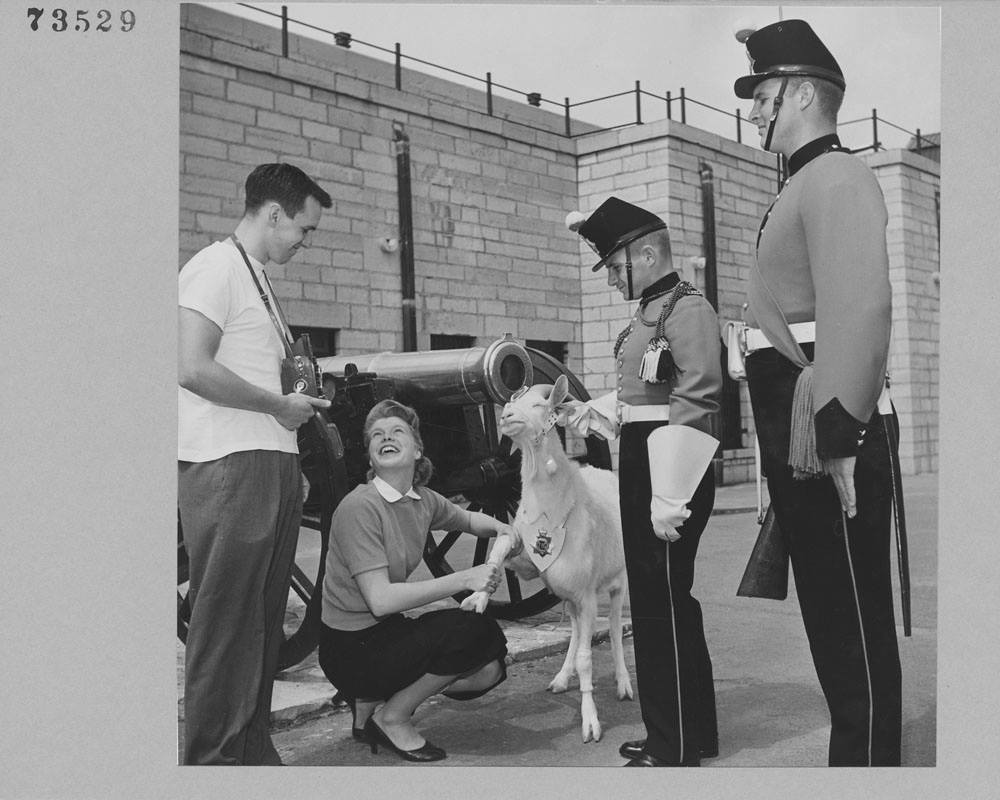
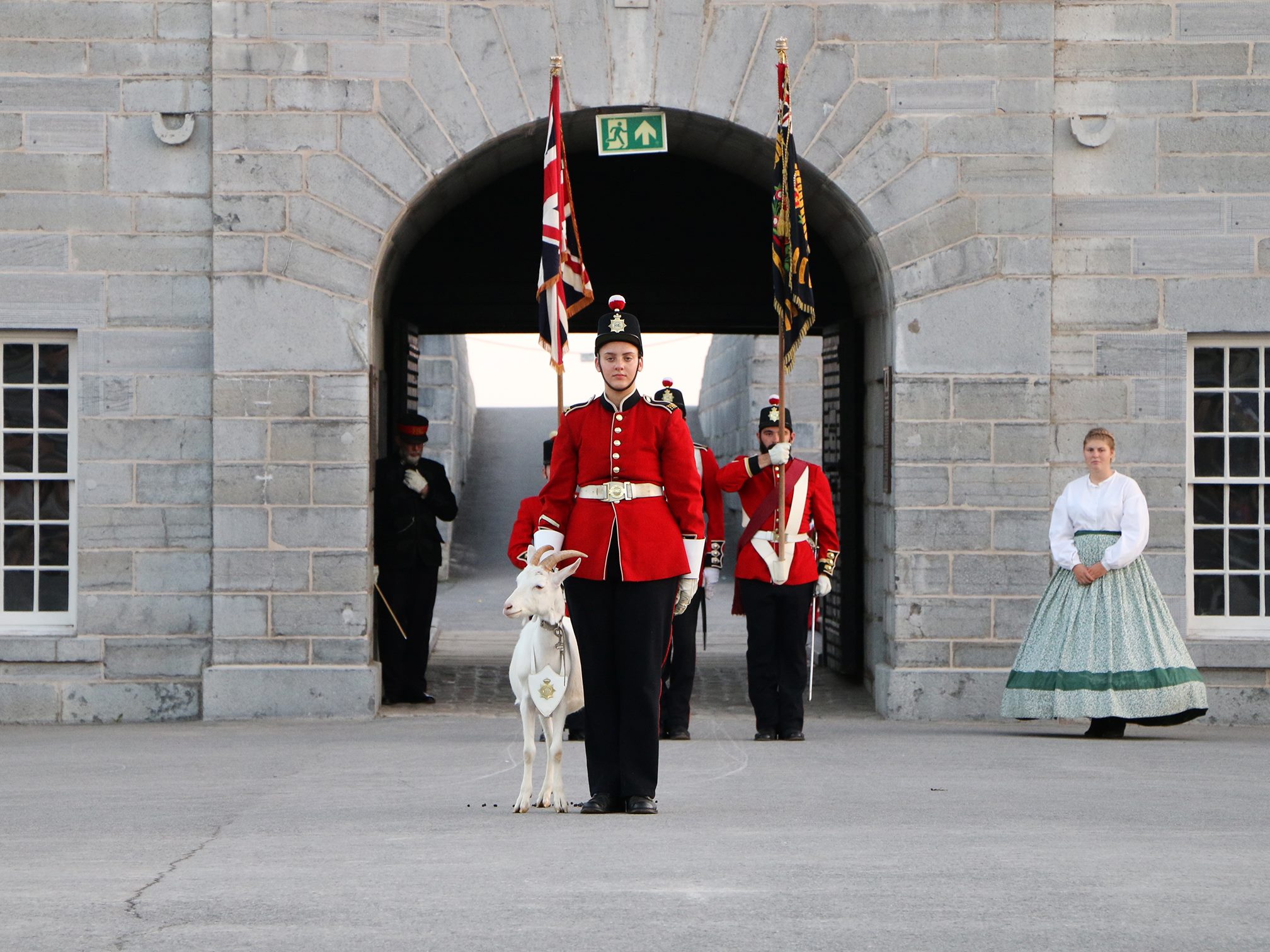
Notes and Credits:
Footnotes:
- [1] “This foreign direct investment is valued at $332 million dollars and is expected to generate at least 200 direct and 1600 indirect jobs in Canada” (Hirtenfelder and Prouse, 2021. Milking Economies: Multispecies entanglements in the infant formula industry. EPE: Nature and Space, 0(0): 1-23.
- [2] Kingston Economic Development Corporation, “Success Stories: Feihe Canada Royal Milk,”
- [3] In 2022 the activist group Evolve our Prison Farms released a critical report about the abattoir at this facility titled “Bloody Bad Business”. The contract with Wallace Beef, who operated the abattoir, was terminated in October 2022, but could be reinstated with a new private partner..
- [4] McGregor, J., 2021. “Workers at baby formula plant claim harassment by managers,” Available from CBC News
- [5] McGregor, J., 2020. “Public servant who promoted $225M baby formula plant now sits on Chinese investor’s board,” Available from CBC News
- [6] Green, J., 2021. “New Report questions goat dairy for prison farm,” Available from Frontenac News.
- [7] National Army Museum, “Army Mascots.”
- [8] 31 July 1973, “Guard gets its goat,” The Kingston Whig-Standard, page 19.
- [9] Hilltop History, 2020. “Episode 7: The Coat of the Goat.”
- [10] 7 July 1955, “Fort Henry Guards get Fine welcome in Washington,” The Kingston Whig-Standard, page 18.
- [11] 15 July 1955, “Much to the consternation,” The Kingston Whig Standard. Page 13. This tradition has carried on for a long time. In 1975 he also greeted patients from the St. Mary’s Lake Hospital (11 June 1975, “Wheeling in,” The Kingston Whig-Standard. Page 47.
- [12] Basa, J., “Fort Henry’s mascot goat David gets a new friend,” Available from Global News.
- [13] Hilltop History, 2020. “Episode 7: The Coat of the Goat.” Available from Spotify,
- [14] Hilltop History, 2020. “Episode 7: The Coat of the Goat.” Available from Spotify.
Extras:
- The Goat: A Natural and Cultural History by Sue Weaver
- Canada’s proposed prison farm program: Why it won’t work and what would work better, by Amy J. Fitzgerald and Amanda Wilson
- Goat by Joy Hinson
- The Men who stare at goats by Jon Ronson
- Our transgenic future: Spider goats, genetic modification and the will to change nature by Lisa Jean Moore
- War Animals: The Unsung Heroes of World War II by Robin Hutton.
- Animals and War: Studies of Europe and North America edited by Ryan Hediger.
- Animals in the military: From Hannibal’s elephants to the Dolphins of the U.S. Navy by John M. Kistler.
- Hilltop History: A Fort Henry Podcast.
- Milking Economies: Multispecies entanglements in the infant formula industry, journal article by Claudia Towne Hirtenfelder and Carolyn Prouse.


